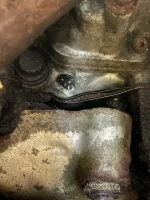Today I had the joy of replacing a radiator on my 2007 Chrysler Pacifica. I've had a tiny coolant leak for eons (top up every few months or so), and it had finally gotten bad enough where I could actually locate it. I saw some coolant residue on the bottom of the bumper cover one day on the driver's side. Not much else in that area to leak other than the radiator. I put a pressure tester on it to rule out the hoses. Problem is you can't see the radiator so I was basically going on a hunch, but when I got it out, it was clearly leaking at the bottom corner where the plastic tank meets the aluminum.
Nothing bad about the repair; one thing about this and other Chryslers I've worked on, is some engineer was using their head when they designed it. I'm sure there's some exceptions, but so far [knock on wood] every job I've done on this car (timing belt, motor mounts, suspension work, etc.) has been fairly straightforward with no surprises. 2 hour job and that was working slow, enjoying a cold beverage or three.
When I was done, I filled & bled the cooling system, no issues. Put a pressure tester after it cooled down to verify no leaks (I always do this after any cooling system repair), and the dang thing is leaking on the driver's side this time, coolant running down the oil pan. Found the leak pretty easily, I wasn't lucky enough to have it be a radiator hose clamp too loose, no, it's actually this part leaking:
It's the housing where the lower radiator hose connects to the engine block. The small hose goes to the engine oil cooler. I'm confident it wasn't leaking before, guess I must have disturbed it while removing/installing the lower hose at the radiator. Probably doesn't take much for 15 year old plastic exposed to all that heat. So now I have another $30 part to replace, requires removing the radiator fans (again) to get access to it, but all in all shouldn't be a bad job. Don't see why they couldn't have used an aluminum housing & metal pipe, but I digress.



